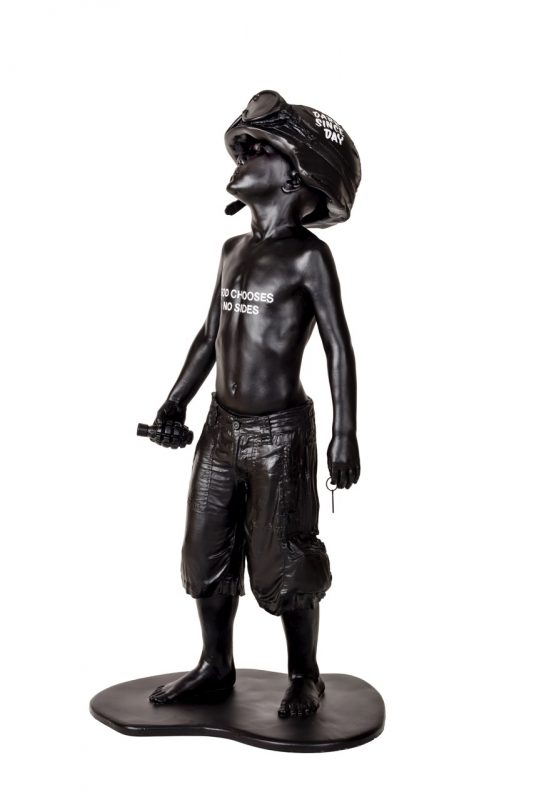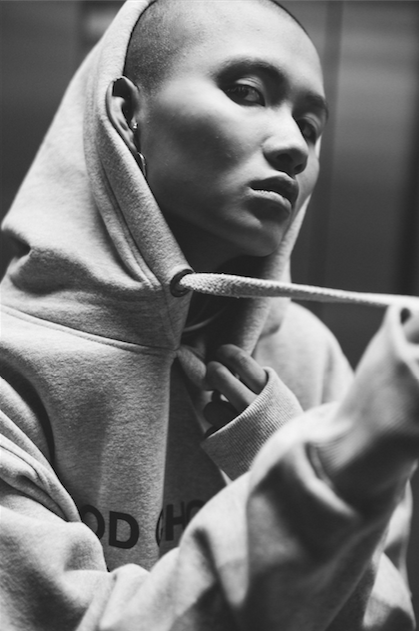FAULT meets Schoony – Hollywood’s favourite artist

Since storming the London art scene in 2008, urban artist Schoony has certainly made his mark within the art world and beyond – his celebrated Boy Soldier sculpture having garnered international recognition, and a number of Hollywood fans.
Boy Soldier is again reincarnated in the artist’s latest collaboration with Woodbury House, along with two more exclusive pieces; FAULT spoke with the multi-talented Schoony to discuss his partnerships with Woodbury House and streetwear brand Dark Circle, his experience across the film and art industries, and the inspirations behind his pioneering hyperrealist sculptures…
You worked in film prosthetics and special effects for a long time – what drew you away from this to become a solo art practitioner?
I took the plunge into a new career as an artist to share a skill and a passion for my artwork, inspired by my work in the film industry.
Your sculpture ‘Boy Soldier’ has been featured in films, and is a favourite among big Hollywood names – what do you think is the appeal of this particular piece?
I think Boy Soldier has become so well-known because it resonates with so many people from every walk of life. Some countries do send their children to war and the repercussions are horrific, and this piece is able to highlight this injustice.
I used a life cast of my nephew Kai for the piece, as he was aged seven when it was created; the same age as some of the soldiers in Afghanistan and Iraq would have been ten years ago, which added an additional level of meaning for me. It is a future I do not want for my nephew, and I think this piece is able to bring that to life.
War and mortality seem to be key themes within your work, what is it about these aspects of society that you find so intriguing to explore in your practice?
War and mortality are both issues that are of huge importance to me, and very much in the forefront of people’s minds, as the media is plagued with horror stories of war and terror happening globally.
My work is able to reach people on a different level to online news or national papers, as people are less able to distance themselves from it or become desensitized to it – it is brought to life in a bigger way. I try to be influenced by everything I see, hear or feel and work on matters that demand attention.
You work predominantly in life cast sculpture, but do you see yourself experimenting with other mediums in future?
I have worked and experimented in many mediums over the years but, primarily, I use fiberglass resin as the foundation for a majority of my works as it is so versatile and robust. I do use various silicones of varying density, pliability and viscosity for my hyper-realistic pieces, as it is almost like the touch of skin.
In recent years, I have branched out into 3D scanning and printing. I own a number of different printers that produce works in different materials: ABS plastic, liquid resin, and powder. I use this medium exclusively now to create the heads for my models as you can achieve a true copy, compared to traditional lifecasting techniques. It’s a long process, but with much better results.
I do also experiment and play with different painting techniques – I particularly like the Montana spray paint range for its vivid dense colours.

Are there artists, past or current, who you have found inspiration in, or whose work you admire?
I have always been a huge fan of James Jean – I’m always amazed by the work he produces. In terms of artists who I feature on my walls at home, I have numerous Jeremy Geddes, James Jeans, Pipsqueak, and my most recent acquisition is a light work from Max Patte, from an astounding show that was held at Sir Ian McKellen’s house.
You recently collaborated with Woodbury House Contemporary Art on three exclusive pieces – how did the collaborative process behind that come together?
I have worked with Woodbury House for a number of years, and we have a great working relationship. They put forward the opportunity to do a three-way collaboration with Dark Circle, and I immediately jumped at the idea.
Having the chance to work collaboratively with Woodbury House and Dark Circle has been a unique and highly inspiring artistic process; we’ve been able to amalgamate two very different artistic styles to create a unique range of works.
I was especially excited by the fresh look and feel the Boy Soldier sculpture was given by the Dark Circle team, and I love the design they have worked into my creation.
As well as your Boy Soldier sculpture, you also created two-panel pieces for the collection – Butterfly Kiss and Bruiser – what were your inspirations behind these works?
The inspiration for Butterfly Kiss was based on the short lifespan butterflies have, some only living days or weeks. The sculpture shows the same person in this moment together, and through this connection, they create the shape of a butterfly.
The sculpture was a life cast of my wife and, to me, showcased how fleeting and short-lived love can be and to appreciate the time you have, to appreciate the beauty, and to love yourself.
When my daughter was born in December 2015, it made me realize how women can be repressed and feared by certain groups in this world. Bruiser was taken as a 3D scan of my mate’s daughter, as I wanted to make a piece that represented that underlying strength and power that all women have.
You’ve also recently collaborated with the clothing brand Dark Circle to create a collection around these three pieces – is fashion an area that you’re interested in, either as a medium to create works, or more widely as a part of modern society and self-expression?
I love fashion! Fashion and art go hand in hand. It’s a form of art and self-expression; the way somebody dresses can speak a thousand words. If I can spread my ideas through this medium, then I really like the idea of art being able to cross all borders and giving anyone the chance to own something that speaks to them.
I am always open to new and creative ways to bring my work to the masses – and it’s pretty cool to see your work walking down the street!

There is a lot of discussion about the art industry’s accessibility, pricing and regulation – what are your thoughts on this?
Anything that can make art feel more accessible and available to a wider range of people has my backing. Art should be attainable to all, and not a select few.
What is your FAULT?
One of my biggest faults is money – I get through it too easily!
Words: Jennifer Sara Parkes